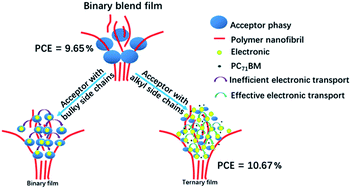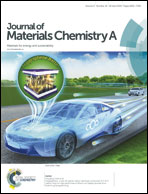High efficiency ternary polymer solar cells based on a fused pentacyclic electron acceptor†
Abstract
Nonfullerene acceptors (NFAs) with a fused-ring backbone usually tend to form large aggregations in the active layer when blended with polymer donors. One solution is to increase the steric hindrance by introducing bulky side chains onto the planar backbone; however, the enlarged intermolecular distance hampers the effective transport of electrons. Here, we provide a ternary-blend strategy to suppress the aggregation of NFAs but preserve their close π–π stacking in the nanophase. Using this method, a fused pentacyclic electron acceptor IDT-2O, which has fewer fused rings and a simpler synthetic route than commonly used heptacyclic and nonacyclic acceptors, can surprisingly demonstrate a high power conversion efficiency of 10.67%, higher than those of the corresponding binary devices. In such ternary-blend devices, PC71BM was selected as the third component to improve the film morphology and enhance the charge transport ability. As a result, increased short-circuit current and fill factors were achieved in these ternary-blend solar cells, giving rise to boosted photoelectric conversion efficiency.

- This article is part of the themed collection: 2018 Journal of Materials Chemistry A HOT Papers


 Please wait while we load your content...
Please wait while we load your content...